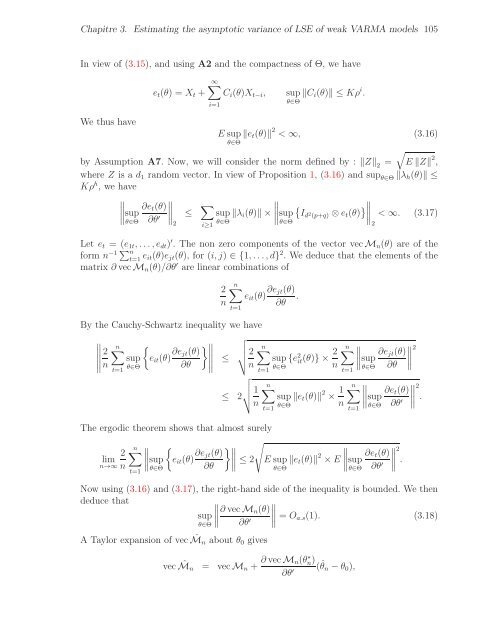THÈSE Estimation, validation et identification des modèles ARMA ...
THÈSE Estimation, validation et identification des modèles ARMA ...
THÈSE Estimation, validation et identification des modèles ARMA ...
You also want an ePaper? Increase the reach of your titles
YUMPU automatically turns print PDFs into web optimized ePapers that Google loves.
Chapitre 3. Estimating the asymptotic variance of LSE of weak V<strong>ARMA</strong> models 105<br />
In view of (3.15), and using A2 and the compactness of Θ, we have<br />
<strong>et</strong>(θ) = Xt +<br />
2<br />
i≥1<br />
∞<br />
i=1<br />
Ci(θ)Xt−i, supCi(θ)<br />
≤ Kρ<br />
θ∈Θ<br />
i .<br />
We thus have<br />
Esup <strong>et</strong>(θ)<br />
θ∈Θ<br />
2 < ∞, (3.16)<br />
<br />
by Assumption A7. Now, we will consider the norm defined by : Z2 = EZ 2 ,<br />
where Z is a d1 random vector. In view of Proposition 1, (3.16) and supθ∈Θλh(θ) ≤<br />
Kρh , we have<br />
<br />
<br />
<br />
sup ∂<strong>et</strong>(θ)<br />
θ∈Θ ∂θ ′<br />
<br />
<br />
≤ <br />
<br />
<br />
supλi(θ)×<br />
<br />
<br />
θ∈Θ<br />
sup<br />
<br />
Id2 (p+q) ⊗<strong>et</strong>(θ)<br />
θ∈Θ<br />
2 < ∞. (3.17)<br />
L<strong>et</strong> <strong>et</strong> = (e1t,...,edt) ′ . The non zero components of the vector vecMn(θ) are of the<br />
form n −1 n<br />
t=1 eit(θ)ejt(θ), for (i,j) ∈ {1,...,d} 2 . We deduce that the elements of the<br />
matrix ∂vecMn(θ)/∂θ ′ are linear combinations of<br />
2<br />
n<br />
n<br />
t=1<br />
eit(θ) ∂ejt(θ)<br />
.<br />
∂θ<br />
By the Cauchy-Schwartz inequality we have<br />
<br />
n<br />
<br />
2<br />
sup eit(θ)<br />
n<br />
t=1<br />
θ∈Θ<br />
∂ejt(θ)<br />
<br />
∂θ<br />
<br />
<br />
<br />
≤ 2 n<br />
sup{e<br />
n<br />
t=1<br />
θ∈Θ<br />
2 n<br />
<br />
2 <br />
it (θ)}× <br />
n <br />
t=1<br />
sup<br />
2<br />
∂ejt(θ) <br />
<br />
θ∈Θ ∂θ <br />
<br />
<br />
<br />
≤ 21<br />
n<br />
sup<strong>et</strong>(θ)<br />
n θ∈Θ<br />
2 × 1<br />
n<br />
<br />
<br />
<br />
n sup ∂<strong>et</strong>(θ)<br />
θ∈Θ ∂θ ′<br />
<br />
<br />
<br />
<br />
The ergodic theorem shows that almost surely<br />
n<br />
<br />
2 <br />
lim <br />
n→∞ n sup <br />
eit(θ)<br />
θ∈Θ<br />
∂ejt(θ)<br />
<br />
<br />
<br />
≤ 2 Esup <strong>et</strong>(θ)<br />
∂θ θ∈Θ<br />
2 <br />
<br />
×E <br />
sup ∂<strong>et</strong>(θ)<br />
θ∈Θ ∂θ ′<br />
<br />
2<br />
<br />
.<br />
t=1<br />
Now using (3.16) and (3.17), the right-hand side of the inequality is bounded. We then<br />
deduce that <br />
<br />
sup<br />
∂vecMn(θ)<br />
<br />
θ∈Θ ∂θ ′<br />
<br />
<br />
<br />
= Oa.s(1). (3.18)<br />
A Taylor expansion of vec ˆ Mn about θ0 gives<br />
t=1<br />
vec ˆ Mn = vecMn + ∂vecMn(θ ∗ n )<br />
∂θ ′ ( ˆ θn −θ0),<br />
t=1<br />
2<br />
.
















